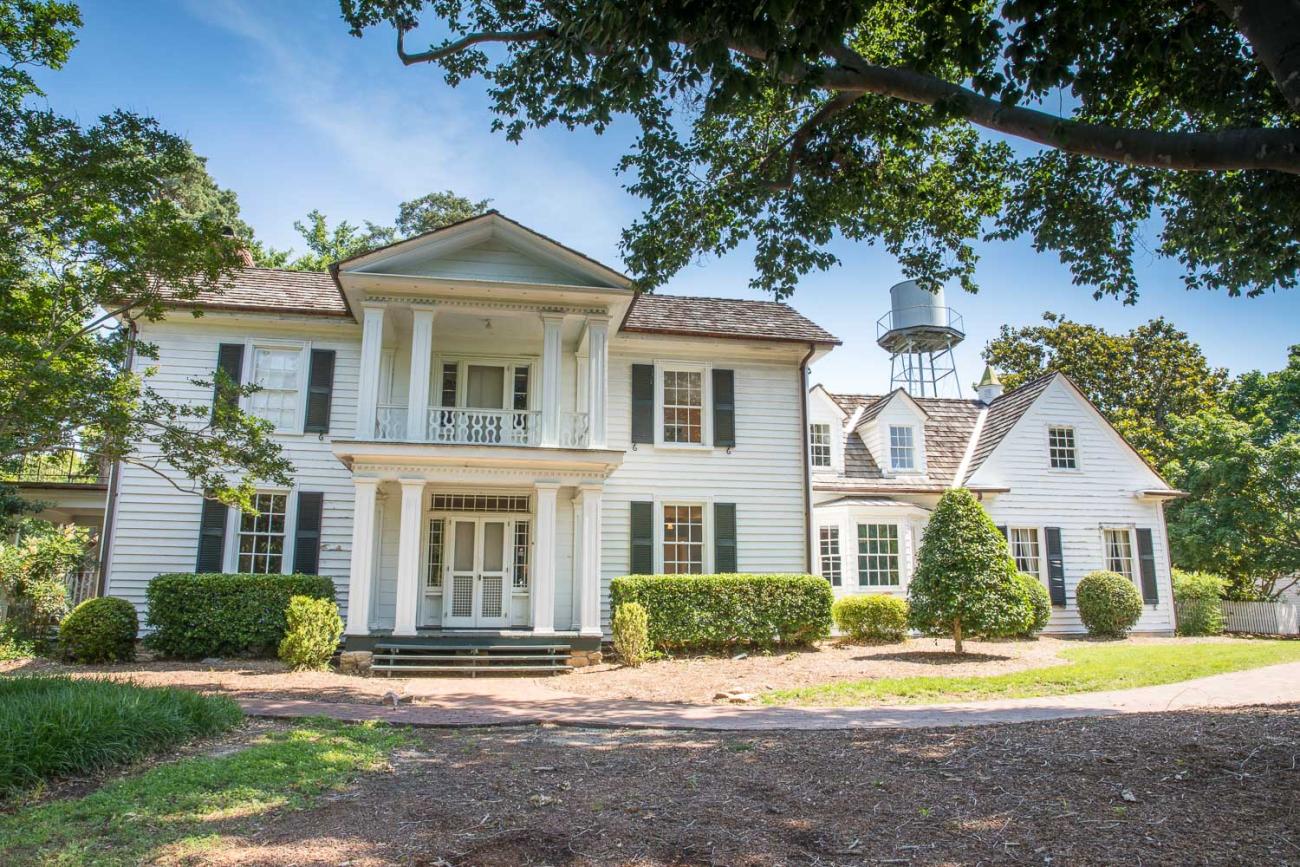
Park Hours
Park Grounds
Monday–Sunday, 8 a.m.–Sunset
Park Buildings
Monday–Saturday, 8:30 a.m.–5 p.m., Sunday, 1–5 p.m.
Follow us on Facebook.
Park News
Job Openings

Historic Oak View is currently hiring part-time Park Aides of Operations and Maintenance. Click here for a job description.
Park Information
Park Rules
- Speed limit is 10 mph.
- Clean up after your pets.
- Keep pets on a 6-foot leash.
- Park only in designated areas. (No parking on roadsides or outside park gates.)
- No unmanned aircraft allowed due to the proximity of nearby helipads.
- The following are prohibited:
- Open fires
- Alcoholic beverages
- Tobacco and vapor products
- Hunting
- Feeding of wildlife
- Swimming, wading, or boating
- Collection or release of any natural material or living organism unless otherwise designated by Wake County Parks, Recreation and Open Space staff
- Amplified music
- Littering
- Firearms
- This does not prohibit concealed handgun permit holders from legally carrying a concealed handgun in accordance with N.C.G.S. 14-415.11
- Overnight parking and camping
- ATVs and other motorized vehicles
Photography at Historic Oak View
Thank you for your interest in choosing Historic Oak View County Park as the site of your photography session. Today Oak View is a park for all, where everyone is welcome. Our mission is to create a park that honors the lives and labor of all those who worked on this land, telling the full history of the enslaved individuals, sharecroppers, and tenant farmers. As you conduct your photography session, we ask that you please keep in mind the important history of the site. Learn more about Oak View's history.
To ensure that all park visitors have an enjoyable experience, registration is required for photo shoots. Click here to register.
Have questions? Please refer to Historic Oak View’s Photography FAQ.
Please follow all Historic Oak View Photography Rules.
Fishing

Historic Oak View has two fish ponds. They are located near the Bluebird Shelter and along the trailhead that begins on the north side of the Farm History Center parking lot. Cane pole fishing is permitted (catch-and-release only). North Carolina freshwater fishing regulations apply (license required for those 16 and older).
Metal Detecting and Magnet Fishing
Wake County Parks, Recreation & Open Space has a "No Collection" policy that does not allow visitors to take things (natural or man-made) from the parks. Our parks contain both historically significant structures and documented cemeteries that should not be disturbed.
Metal detectors and magnet fishing may be used to look for an item you have specifically lost, but not to "treasure hunt" in general. The Park Manager must be notified and grant permission in advance of using a metal detector or magnet fishing to search for a personal lost item.
Drones/RC Vehicles/Model Rockets
Please refer to the Wake County Parks Policy on Drones/RC Vehicles/Model Rockets for questions on use at Historic Oak View County Park.
Group Visits
Planning a Group Visit
Are you bringing a group out to Historic Oak View? You might need a Park Use Agreement. Let us know ahead of time, and we can work with your group to make sure you have a great visit!
Contact us at oakview@wake.gov.
Picnic Shelters
The only facilities at Historic Oak View County Park that are available for rental are the two picnic shelters. Each shelter has picnic tables, a water fountain, electrical outlets and a large charcoal grill.
Reservations can be made by using the online reservation system. Select the link to show the map of Oak View. After picking the correct date, click on the icon of the shelter on the map, which will begin the registration process. You will also have to create an account if you don't already have one. Unreserved shelters may be used free of charge on a first-come, first-served basis. Reserve here.
Bluebird Shelter
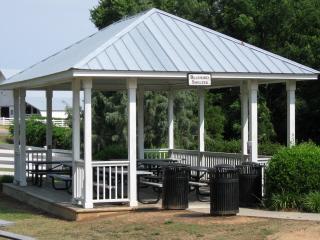
The Bluebird Shelter has a 50-person capacity and costs $60 to reserve. It is located on the left side of the main entrance drive as you enter the park. There are 6 tables under the shelter and 4 uncovered tables on a gravel pad directly adjacent to the shelter.
Carya Shelter
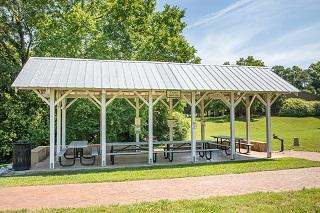
The Carya Shelter has a 30-person capacity and costs $40 to reserve. It is located closer to Poole Road, behind the Olivia Raney Local History Library. There are 4 tables under this shelter.
Park Trails and Features
Farm History Center
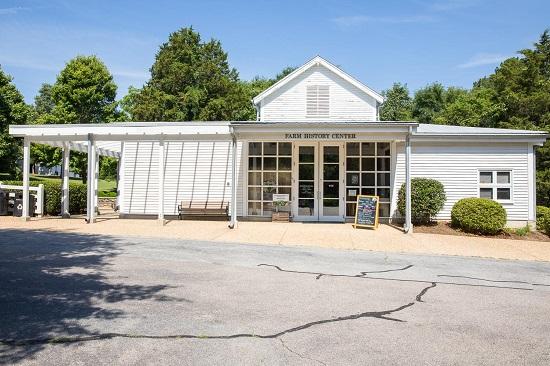
The Farm History Center serves as the park’s Visitors Center. When you are visiting Oak View, be sure to stop in and get an informational brochure and introduction to the site.
The Farm History Center features exhibits that tell the story of agricultural history in North Carolina, including an authentic sharecropper’s cabin. It is also the site of the Farmer's Corner, an interactive area where kids can learn about farming through play, and also where you can check out our Adventure Backpacks, self-guided activity kits geared toward children that teach about different topics of Oak View's history through hands-on activities and games.
Farmer's Corner

The “Farmer’s Corner,” located in the park’s Farm History Center, is an interactive area that encourages learning and play.
The Farmer’s Corner is dedicated to the memory of Kit Boney, an enthusiastic volunteer who was instrumental in gaining community support and funding to open Historic Oak View as a public historic site in the 1990s. Boney was a strong advocate for the educational value of the site.
Goats
Visiting the goats is one of the most popular activities for guests at Historic Oak View County Park. The goats love the attention and you can usually find them grazing in the corral behind the Tenant House. They’re not too fond of rain, though, so on rainy days you can visit them in the Livestock Barn.
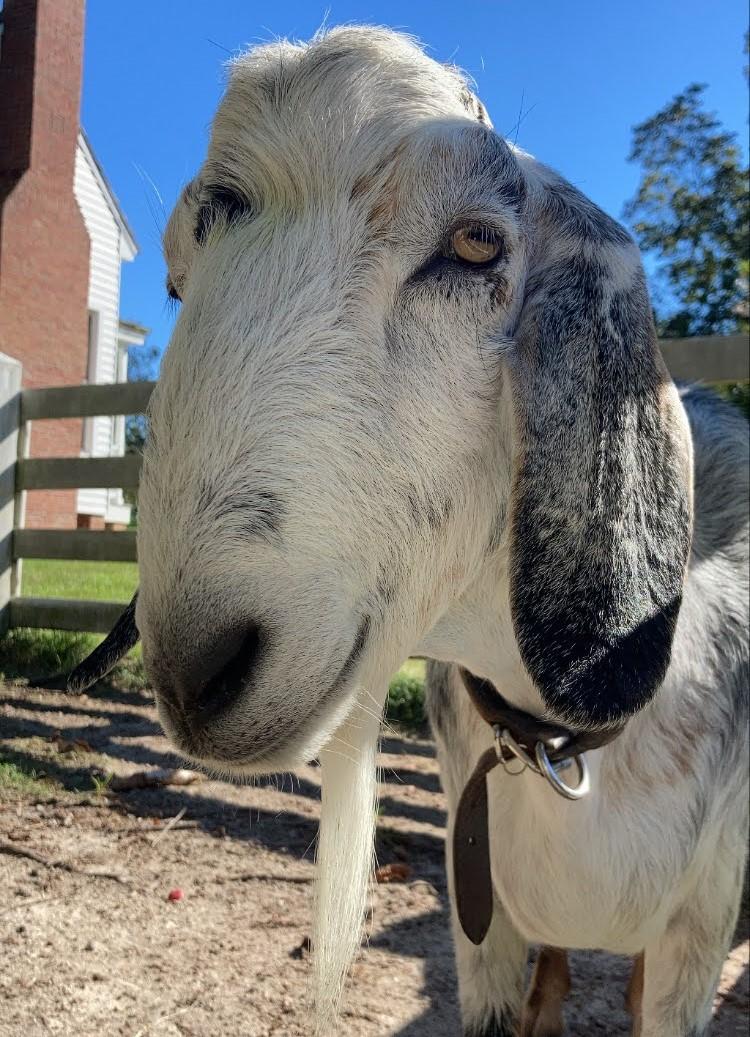
Hi, I am Felix! Leroy and I were both born on a farm near Winston-Salem, NC in early 2017. Both of us are Mini-Nubians, which means we are smaller than Levi, who is a Nubian goat. Did you know that I am the fluffiest goat at Oak View? My hair is soft and silky, and I have the longest beard! When I go “BAAAH” you’ll notice that I have the deepest voice in the pack!

Hi, I am Leroy! Like Felix, I was born on a farm near Winston-Salem, NC, and moved to Oak View in April 2017 when we were three months old. Felix and I are Mini-Nubians, which means we’re half Nigerian Dwarf goats and half Nubian goats. Did you know that my name means “The King” in French? I may not be royalty, but – like all Nubian goats – I do have king-sized ears that are long and bell shaped!

Hi, I am Henry! I was born on a farm near Wake Forest, NC at the beginning of 2021, along with my brother Oscar. We are the newest goats at Oak View and are excited to join the herd. We arrived at Oak View in March 2021 and are 3 months old. I'm a sweet and friendly boy, and I love chin scratches!
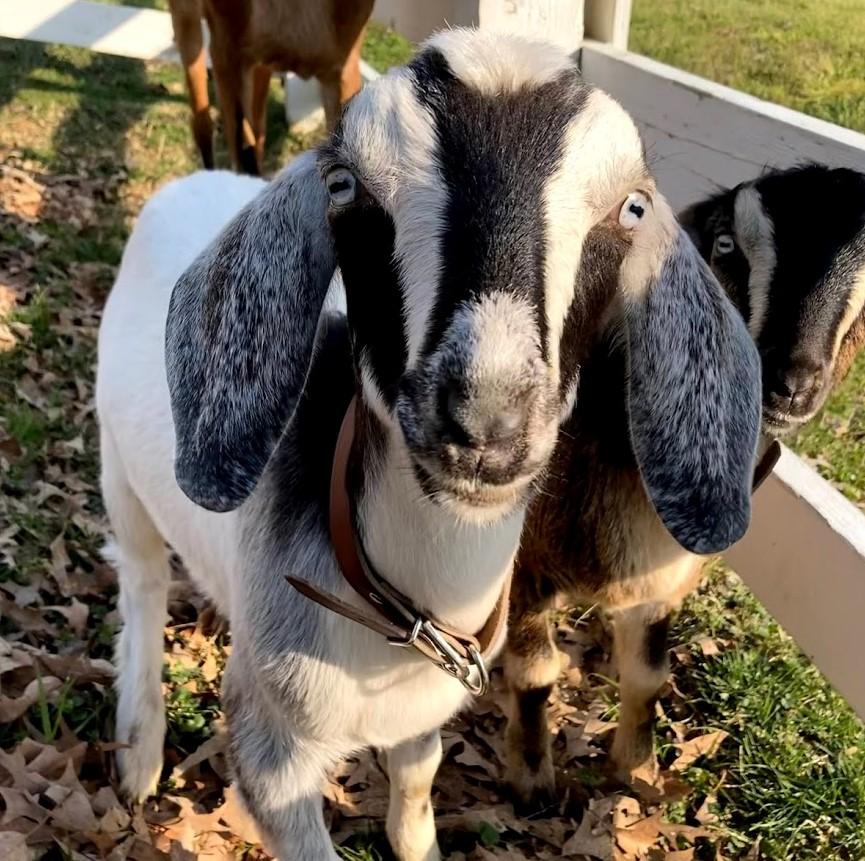
Hi, I am Oscar! My brother Henry and I are both Mini-Nubian goats, just like Leroy and Felix. Did you know that goats have four stomachs? We are ruminants, which means that we regurgitate our “cud,” or partially digested food, and chew it again several times. Yum!
Check out our Goat Gallery featuring student drawings from our January 2021 "Let's Draw Goats" class!
Chickens
Visit Oak View’s chickens in their coop, located beside the Tenant House. The park has four different breeds of chickens: Ameraucanas, Rhode Island Reds, Sapphire Olive Eggers and Silver Laced Wyandottes.
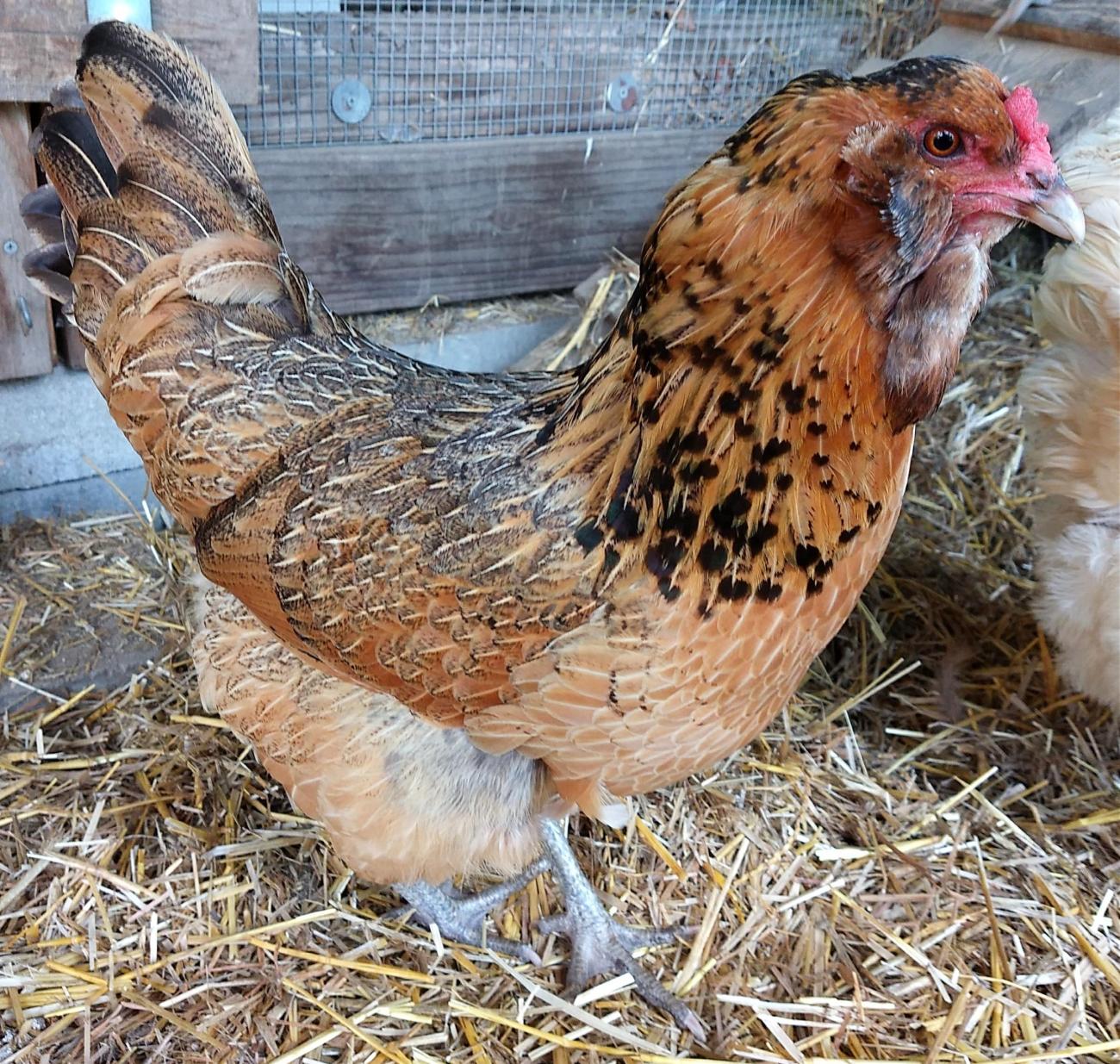
Oak View’s two oldest hens are Ameraucanas, the most evasive of the flock. Their feathers are predominantly brown with buff and black color mixed in. Ameraucanas typically lay medium-sized eggs, and the color is often various shades of blue.
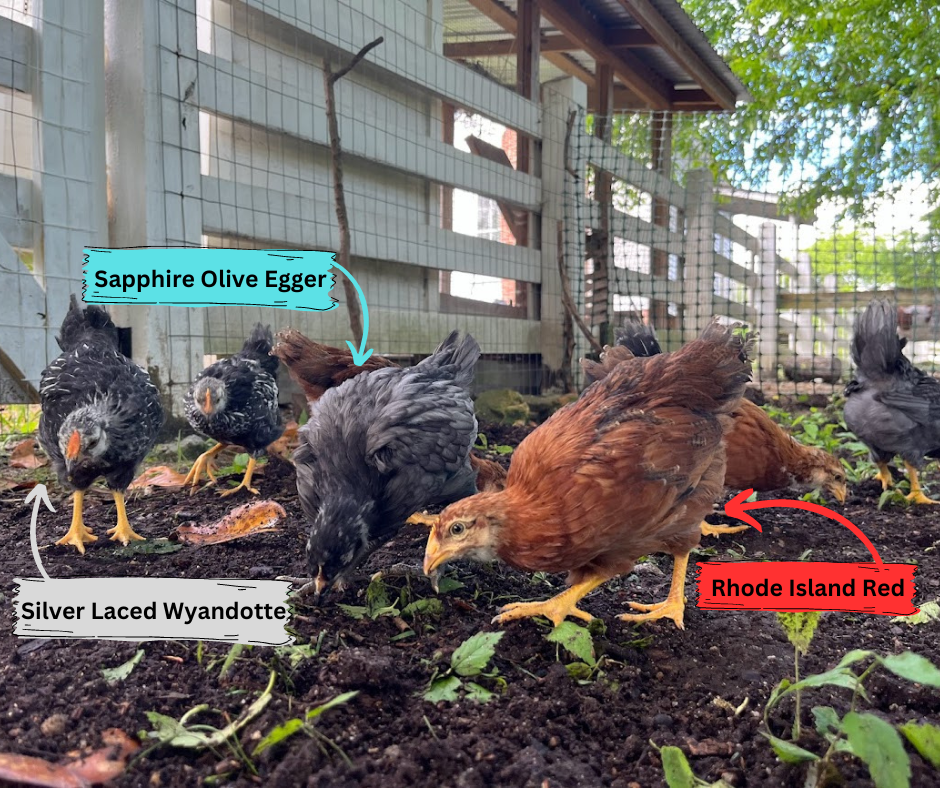
Three park also has three new hen breeds, born in the Spring of 2023, Rhode Island Reds, Sapphire Olive Eggers and Silver Laced Wyandottes.
Rhode Island Reds originated in Little Compton, Rhode Island in the mid-1800’s, making it one of the oldest American-bred chicken breeds. Rhode Island Red hens can lay around 4-6 brown eggs per week.
Sapphire Olive Egger chickens produce beautiful olive-colored eggs. They are a very friendly hybrid breed that has smoky blue feathers and a tuft on their heads.
Silver Laced Wyandottes are one of Americas’ oldest and most well-known and loved breeds. They are colorful, hardy and good egg layers.
Hunnicut Trail
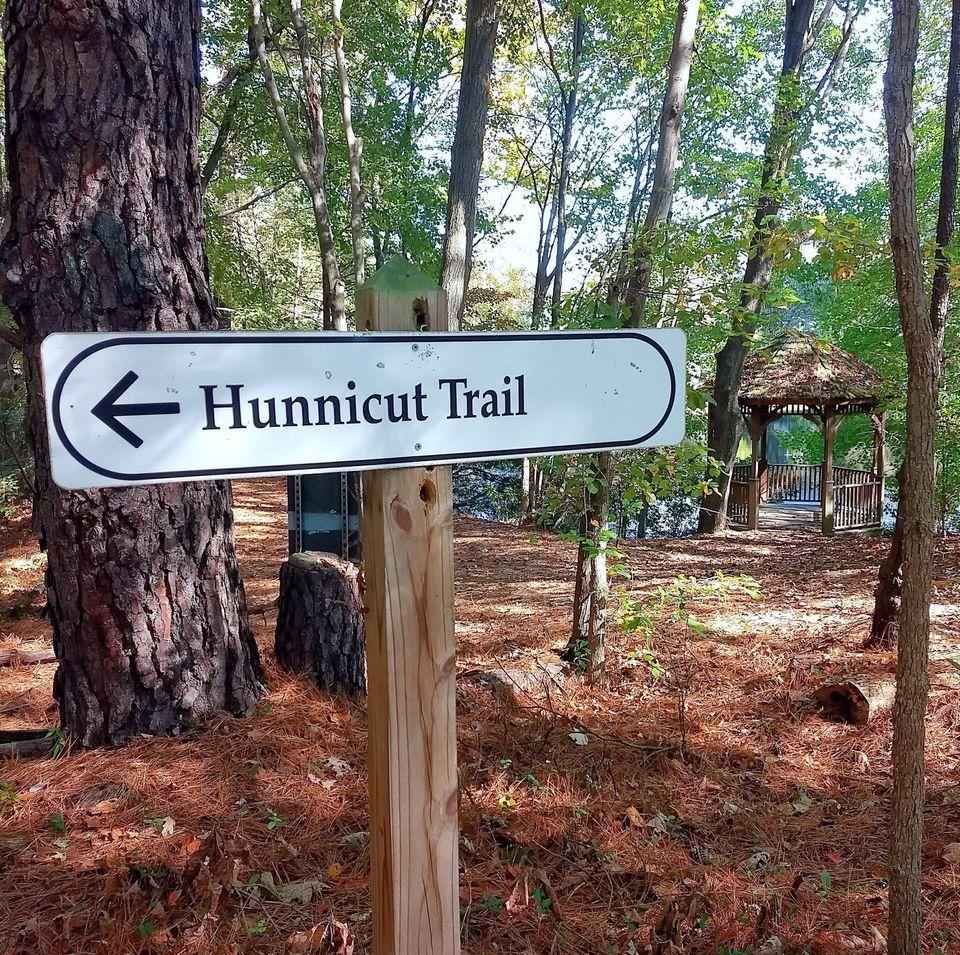
Hunnicut Trail (4/10-mile): The Hunnicut Trail entrance is located off of the trailhead that begins on the north side of the Farm History Center parking lot. This easy loop traverses fairly level ground and its path is wide enough to accommodate strollers. It meanders through a forested area that was once a pasture for the dairy barn at Oak View.
Jones Creek Trail
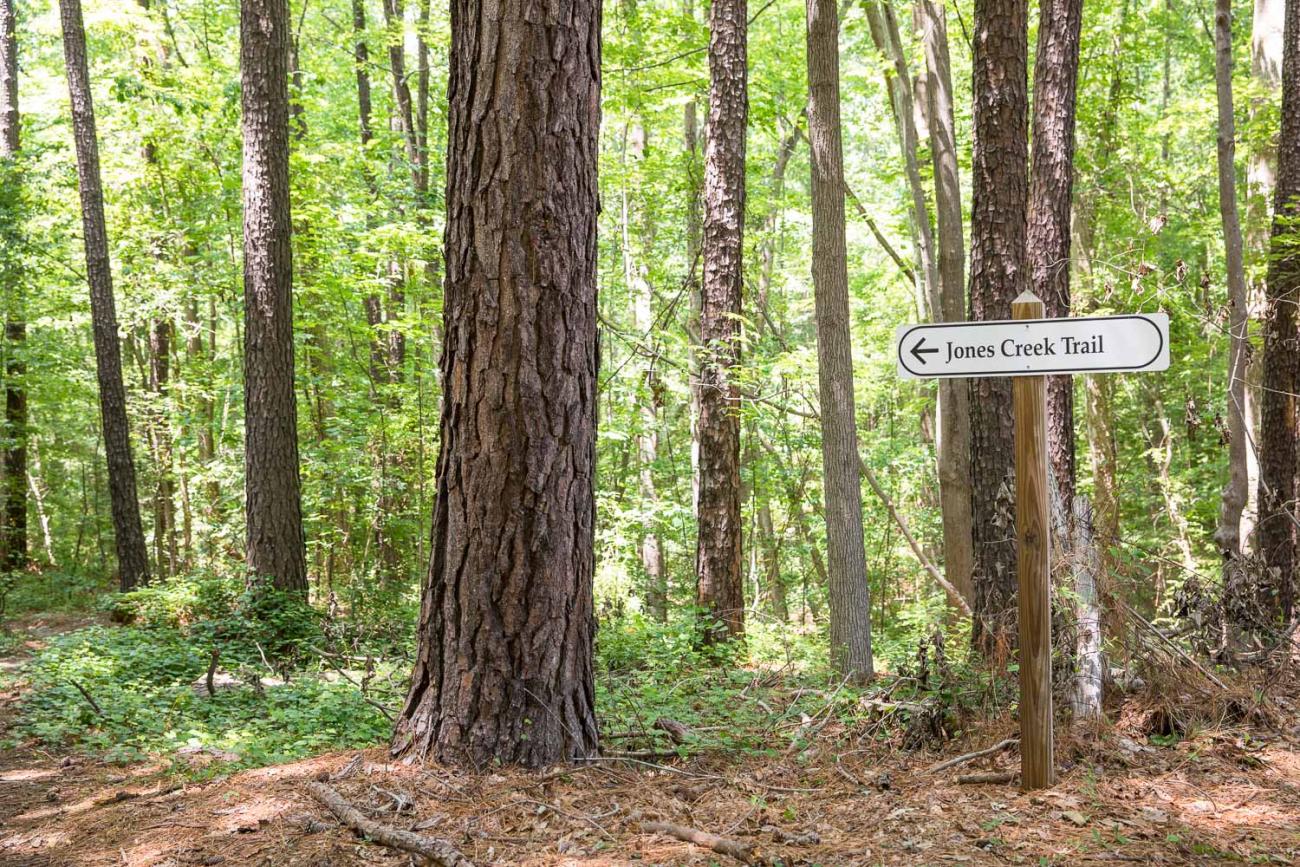
Jones Creek Trail (7/10-mile): The Jones Creek Trail entrance is located off of the trailhead that begins on the north side of the Farm History Center parking lot. This easy-to-moderate dirt trail follows the Jones Creek, then wanders through a cedar and pine forest before returning to the creek. It is not stroller-friendly.
Gardens and Orchards
Cotton Field
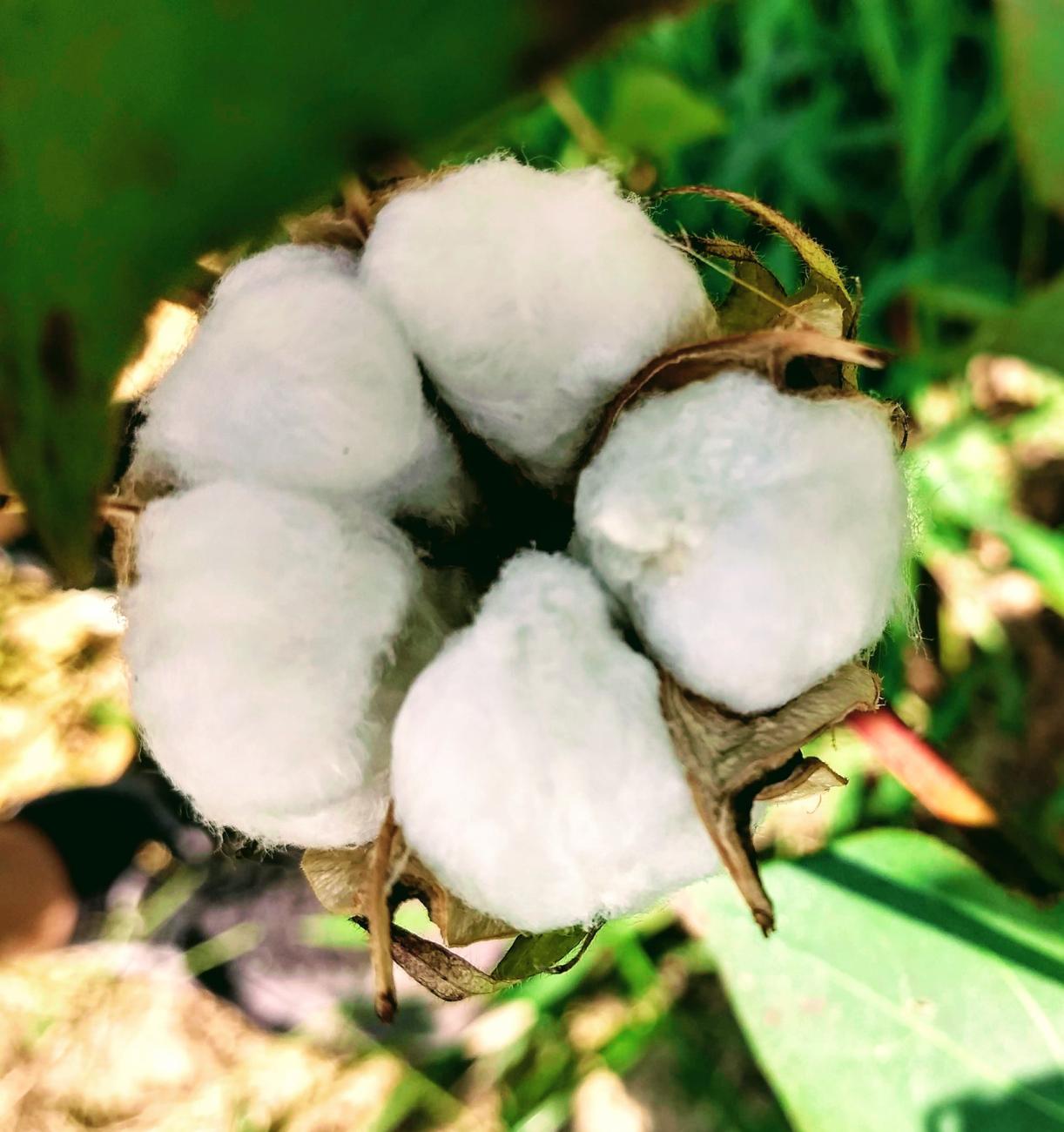
An important part of North Carolina’s agricultural industry, cotton was the leading crop in Wake County and throughout the Southern United States from the late 18th century to the early 20th century. Today the Oak View cotton field is only a fraction of its former size, but in the 1860s the plantation spanned over 900 acres and produced 23 bales of cotton annually. Cotton is a labor-intensive crop, requiring difficult and back-breaking work. Oak View began producing cotton in the 1830s, when the Williams family owned the plantation. During that time, Benton Williams enslaved fourteen men, women, and children, and depended on their labor, knowledge, and skills to produce the cotton crop. After the Civil War, landless farmers (sharecroppers, tenant farmers, and farm laborers) tended the cash crop. Oak View produced cotton until the late 1920s, when the infestation of the boll weevil forced an end to its production and devastated the southern cotton industry.
Cotton seeds are planted in the spring, with the first flowers blooming in the beginning of July. By early fall, the cotton can be harvested. Take a look at the panel next to the cotton field, and see if you can determine what stage Oak View’s cotton plants are in their growing cycle.
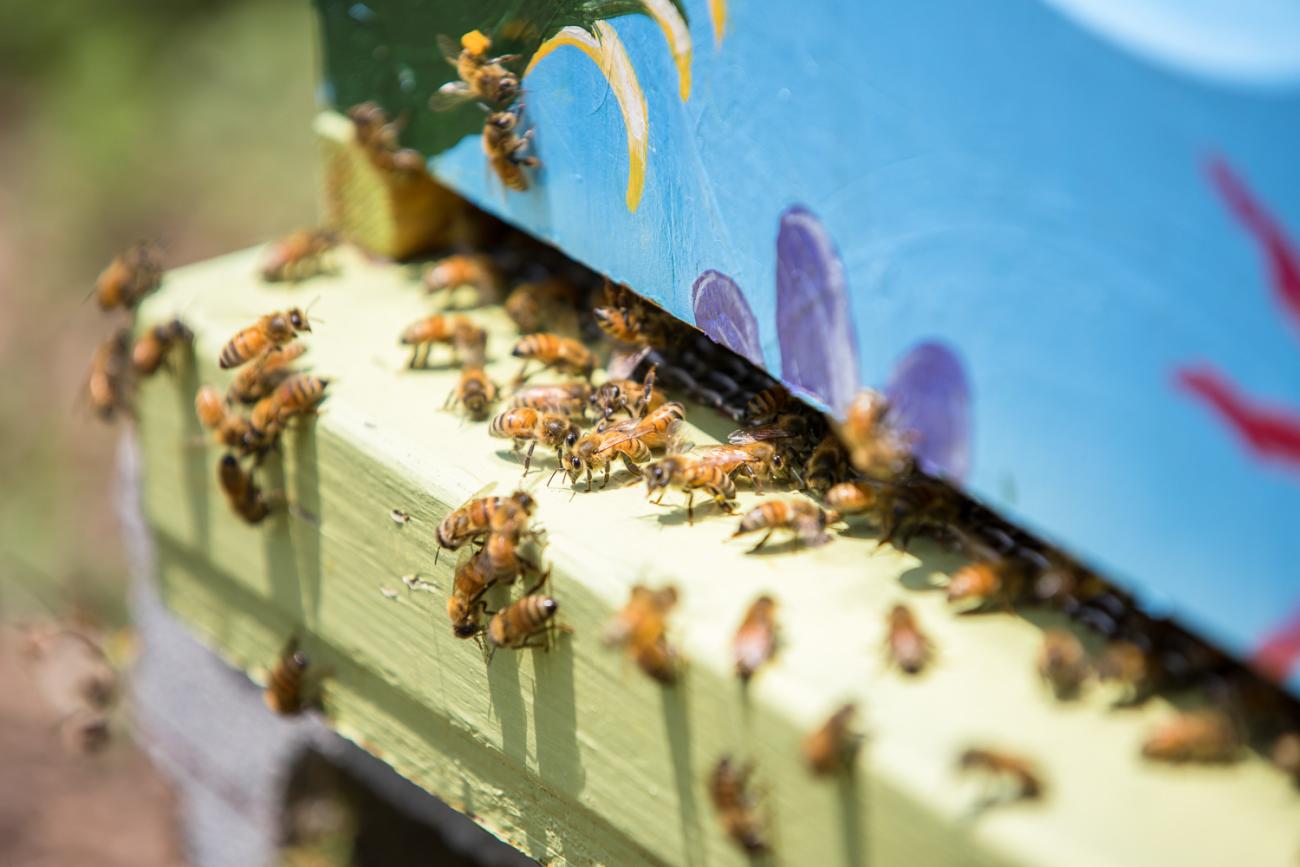
The beehives installed at the edge of the cotton field are cared for by the Wake County Beekeepers Association. The resident bees help to pollinate the cotton crop.
Fruit Orchard
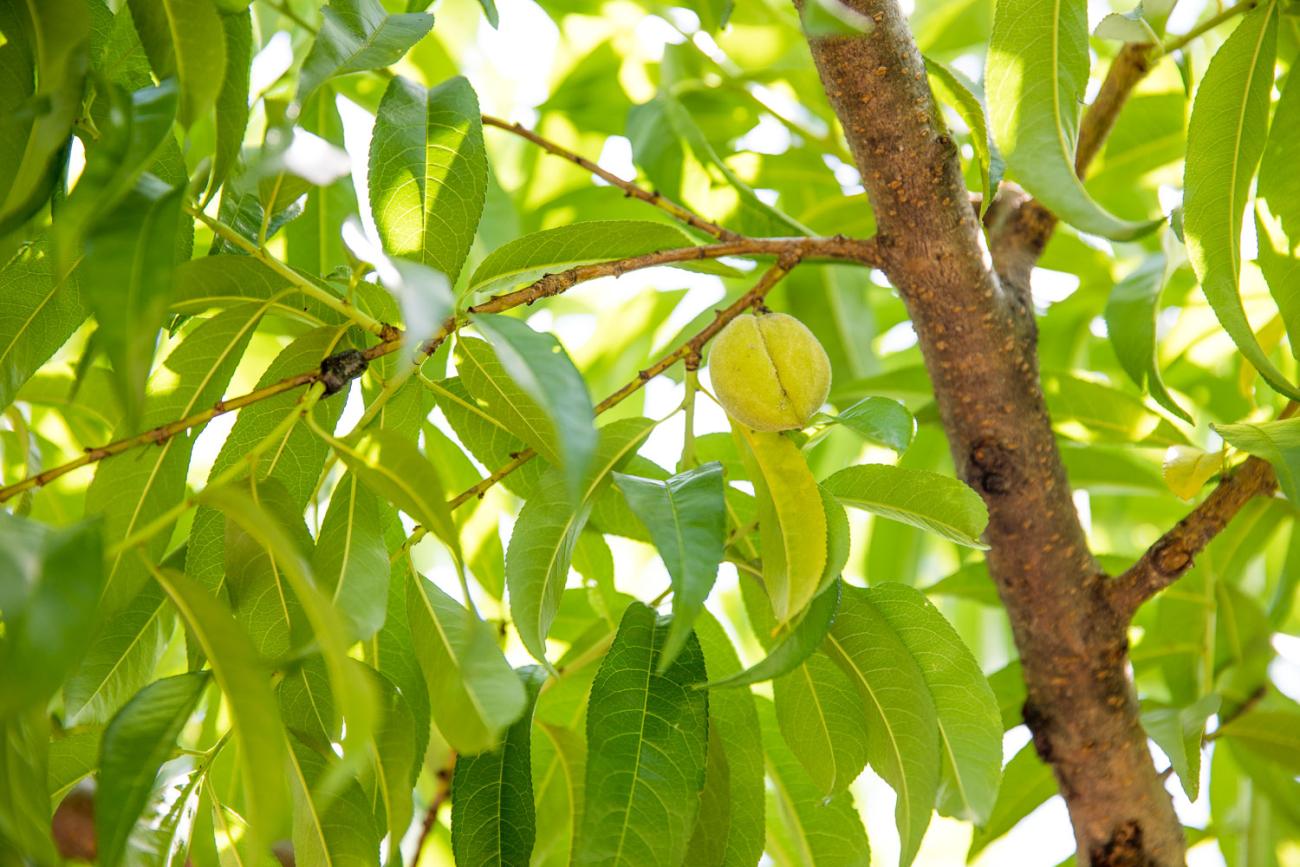
Oak View’s fruit orchard features a variety of fruit trees and grape vines that thrive in North Carolina, including peach, cherry, pear, fig and apple trees as well as muscadine and scuppernong grape vines.
Kitchen Gardens

Situated next to the Plank Kitchen is a small kitchen garden that once was used for growing various fruits, but is now used for growing herbs. The herb and vegetable garden was originally located next to the carriage house but was eventually moved to its current location. On the farm, herbs were used for seasoning food, scenting soaps, or as remedies for ailments. Fresh fruits and vegetables from the garden would have been preserved for use throughout the year.
Pecan Grove
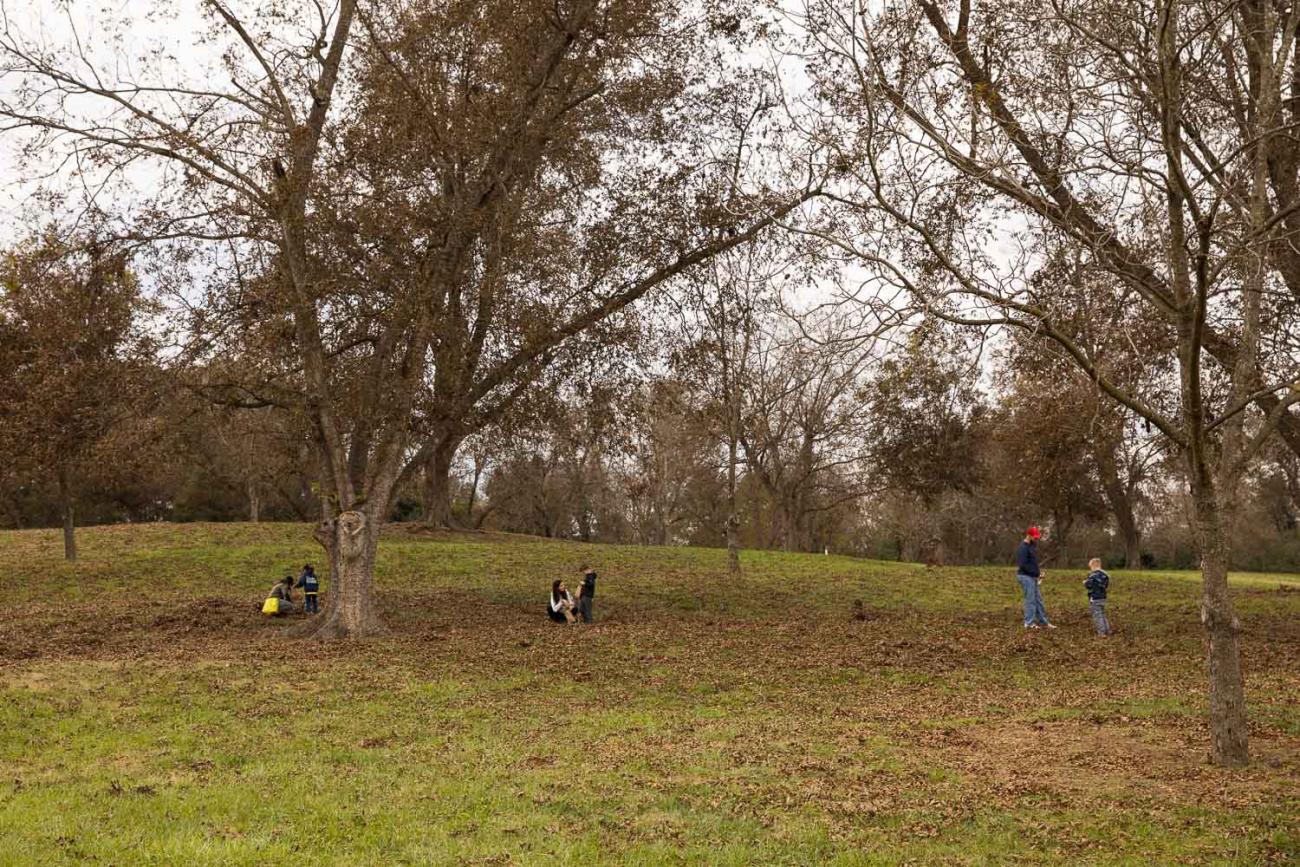
The Pecan Grove was planted in the early 20th century under the direction of Job P. Wyatt in order to supplement the farm’s income following the devastation of the Boll Weevil. Today the park retains a little less than 10 acres of a formerly much larger pecan grove. The beltline cut through what was once part of Oak View’s property. Eighty of the trees in the pecan grove were blown down during Hurricane Fran in 1996, but replacement trees were planted the following year.
Give us your feedback!
If you’ve had the opportunity to visit Historic Oak View County Park, we’d love to hear about your experience! Please take our online survey.
